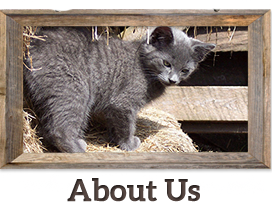Library
-
Pleural effusion is the abnormal accumulation of fluid in the chest cavity. Fluid accumulates in the pleural sac, not the lungs, so the lungs are essentially floating in a chest full of fluid. This fluid occupies space within the chest, so the lungs cannot expand as fully as they should. Treatment and prognosis vary depending on the underlying cause.
-
Pneumothorax is an accumulation of air outside the lungs, but inside the chest wall. The air outside the lung prevents the lungs from inflating normally, and can lead to lung collapse. There are several variations of pneumothorax.
-
Polycystic Kidney Disease (PKD) is an inherited condition that causes multiple cysts (fluid pockets) in the kidneys. Persian cats and breeds with Persian bloodlines are most commonly affected. The clinical signs, diagnosis, genetic testing, and treatment options are explained in this handout.
-
Polycythemia vera is a rare disease of dogs and cats in which too many red blood cells are produced by the bone marrow. The blood becomes thick and has difficulty moving through the small blood vessels. Your pet may feel tired, sluggish, and weak. Polycythemia is a potentially fatal disease, but if discovered early enough, treatment may be possible. If left untreated, polycythemia vera can affect the heart.
-
Polyethylene glycol is an off-label laxative used to treat constipation and empty the colon in preparation for procedures such as colonoscopy. The most common side effects are diarrhea, flatulence, and abdominal cramping. Do not use it in pets that are allergic to it or in pets with an intestinal blockage/obstruction.
-
Polymyxin B/miconazole/prednisolone otic (brand name Surolan), is a combination antibacterial (polymyxin B), antifungal (miconazole), and anti-inflammatory steroid (prednisolone) ear drop medication. It is used to treat ear infections in cats and dogs. It is used “off label” or “extra-label” in species other than cats and dogs and to treat conditions other than ear infections. Polymyxin B/miconazole/prednisolone otic comes in an otic suspension form.
-
Polysulfated glycosaminoglycan is an injectable disease-modifying osteoarthritis drug (DMOAD) used to treat non-infectious and traumatic arthritis in dogs. It is also used off-label in cats and small mammals. If administering this medication at home, follow your veterinarian’s instructions and dispose of the needle and syringe appropriately. Side effects are rare when given according to label recommendations and at prescribed intervals. Do not use this medication in pets with a known hypersensitivity to it, in pets with known or suspected bleeding disorders or immune-mediated arthritis, or in pets with severe kidney or liver disorders.
-
Ponazuril is given by mouth and is used on and off label to treat protozoal parasites in several animal species. Side effects are uncommon but may include soft stools.
-
When your cat comes home after an operation, special care must be taken to ensure he remains indoors with restricted activity and cannot lick or chew at his incision site. Monitor your cat for abnormal signs and contact your veterinarian if any are observed.
-
This handout explains post-vaccination sarcomas (also called injection-site sarcomas) in cats. They are a rare consequence of vaccine injections (and other drugs or materials) that can cause a very aggressive form of cancer at the site of the injection. The incidence of this condition, as well as precautions you and your veterinarian can take, are highlighted.


